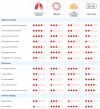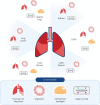Innovative three-dimensional models for understanding mechanisms underlying lung diseases: powerful tools for translational research
- PMID: 37495250
- PMCID: PMC10369168
- DOI: 10.1183/16000617.0042-2023
Innovative three-dimensional models for understanding mechanisms underlying lung diseases: powerful tools for translational research
Abstract
Chronic lung diseases result from alteration and/or destruction of lung tissue, inevitably causing decreased breathing capacity and quality of life for patients. While animal models have paved the way for our understanding of pathobiology and the development of therapeutic strategies for disease management, their translational capacity is limited. There is, therefore, a well-recognised need for innovative in vitro models to reflect chronic lung diseases, which will facilitate mechanism investigation and the advancement of new treatment strategies. In the last decades, lungs have been modelled in healthy and diseased conditions using precision-cut lung slices, organoids, extracellular matrix-derived hydrogels and lung-on-chip systems. These three-dimensional models together provide a wide spectrum of applicability and mimicry of the lung microenvironment. While each system has its own limitations, their advantages over traditional two-dimensional culture systems, or even over animal models, increases the value of in vitro models. Generating new and advanced models with increased translational capacity will not only benefit our understanding of the pathobiology of lung diseases but should also shorten the timelines required for discovery and generation of new therapeutics. This article summarises and provides an outline of the European Respiratory Society research seminar "Innovative 3D models for understanding mechanisms underlying lung diseases: powerful tools for translational research", held in Lisbon, Portugal, in April 2022. Current in vitro models developed for recapitulating healthy and diseased lungs are outlined and discussed with respect to the challenges associated with them, efforts to develop best practices for model generation, characterisation and utilisation of models and state-of-the-art translational potential.
Copyright ©The authors 2023.
Conflict of interest statement
Conflict of interest: M. Nizamoglu reports grants from Boehringer Ingelheim; outside the submitted work. M.M. Joglekar reports support for the present manuscript from Graduate School of Medical Sciences, University of Groningen, The Netherlands. C.R. Almeida reports grants from Fundação para a Ciência e a Tecnologia; consulting fees from Fundação para a Ciência e a Tecnologia; and travel support from Fundação para a Ciência e a Tecnologiam, outside the submitted work. A-K. Larsson Callerfelt reports grants from Swedish Heart Lung Foundation and from EMPIR 18HLT02 AeroTox project; outside the submitted work. The EMPIR programme is co-financed by the Participating States and from the European Union's Horizon 2020 research and innovation programme. I. Dupin reports grants from Fondation Bordeaux Université, the Agence Nationale de la Recherche (ANR-21-CE18-0001-01); and a patent granted for “New compositions and methods of treating and/or preventing chronic obstructive pulmonary disease” (EP 3050574) and patent pending for “New compositions and methods of treating COVID-19 disease” (EP20173595.8); outside the submitted work. O.T. Guenat reports grants from Swiss National Science Foundation (no. 185365), Eurostars (H2020) (project no. 12977 Aim4Doc), ITN (H2020) (project no. 812954, EUROoC); patents WO2015032889 and WO2018096054 (lung-on-chip), licensed to AlveoliX AG; and is a minority shareholder in AlveoliX AG, Switzerland and AlveoliX Technologies AG, Switzerland; outside the submitted work. P. Henrot reports grants from Bordeaux University Hospital, Fondation Bordeaux Université; lecture honoraria from Rhumatos journal; travel support from Chiesi; and receipt of equipment from Avad; outside the submitted work. L. van Os reports grants from European Union's Horizon 2020 research and innovation programme under grant agreement no. 812954 (EUROoC ITN project), and University of Bern, outside the submitted work. J.K. Burgess reports support for the present manuscript from Nederlandse Organisatie voor Wetenschappelijk Onderzoek (NWO) Aspasia-premie subsidienummer 015.013.010. In addition, J.K. Burgess reports grants from Boehringer Ingelheim, outside the submitted work, and is the Assembly Chair of the Respiratory Structure and Function Assembly within the American Thoracic Society and a board member of the Netherlands Respiratory Society. All other authors have nothing to disclose.
Figures


References
Publication types
MeSH terms
LinkOut - more resources
Full Text Sources
Medical
Miscellaneous
